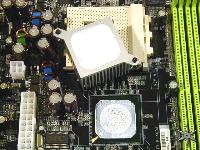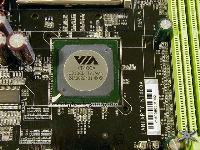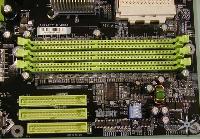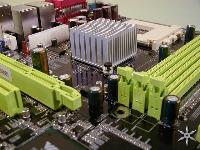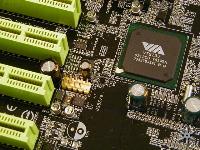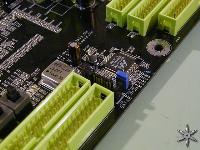After careful consideration I have decided to transfer all hardware review activities to a new domain. I purchased Hardwareasylum.com in 2012 and have been working hard to build a new and improved Ninjalane on that domain. If you are reading this you have reached one of the archived articles, news, projects and/or reviews that were left behind during the site migration.
Please update your bookmarks and be sure to visit the new and improved Ninjalane at Hardwareasylum.com
DFI LanParty KT400A Motherboard Review
Author: Dennis Garcia
Published: Tuesday, June 03, 2003
Board Layout and Features
One of the things that we have started to do here at Ninjalane is inspect how the board manufacturer is attaching the Northbridge heatsink. In the past many companies have just glued a heatsink in place with some thermal epoxy while others have taken the time to use a removable type along with some high quality thermal grease or TIM. We can see here that DFI has chosen the latter of the two methods and supplied an ample amount of thermal paste to boot.
The white grease was later replaced with Artic Silver and reassembled.
The white grease was later replaced with Artic Silver and reassembled.
These next photos are just to give you a tour around the motherboard, The KT400A features the VIA standard of 3DDR DIMM sockets, and it is nice to see the IDE and floppy cables together. You will also notice a set of dipswitches, These are used to select the FSB speed based on your processor. Kind of an old method but works just the same.
The Northbridge cooler is of the passive design and based on overclocked temperature readings the KT400A can benefit from a more active approach to the Northbridge cooler.
The Northbridge cooler is of the passive design and based on overclocked temperature readings the KT400A can benefit from a more active approach to the Northbridge cooler.
The location of the extra USB and firewire connectors always surprises me. They tend to show up in the strangest places and in this case right between two PCI slots. Knowing that most PCI cards are relatively short I'm not totally bothered by this.
According to the chipset map, the KT400A chipset is supposed to support SerialATA natively but instead of using it, DFI included a SerialATA controller chip from Marvell and a single drive connection. The catch is, it can only be used if you aren't already using the onboard IDE RAID controller.
According to the chipset map, the KT400A chipset is supposed to support SerialATA natively but instead of using it, DFI included a SerialATA controller chip from Marvell and a single drive connection. The catch is, it can only be used if you aren't already using the onboard IDE RAID controller.

